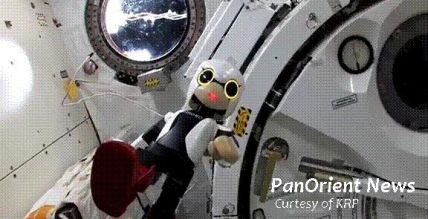|
|
Sci-Tech
Japan’s Robot Astronaut Speaks First Words in Outer Space
Thursday, September 5, 2013

Tokyo- (PanOrient News) The Japan-made robot astronaut Kirobo has become the first robot to speak in outer space, saying, “On August 21, 2013, a robot took one small step toward a brighter future for all”.
Kibo Robot Project is a joint research project carried out between Dentsu Inc., the University of Tokyo’s Research Center for Advanced Science and Technology (RCAST), Robo Garage Co., Ltd. and Toyota Motor Corporation. Japan Aerospace Exploration Agency (JAXA) also provided extensive assistance.
JAXA astronaut Koichi Wakata, the first Japanese commander of the International Space Station (ISS), is expected to arrive at his post in November or December this year. He will then take part in the world’s first conversation held between a person and a robot in outer space, an initiative designed to explore the possibilities of humans coexisting with robots in the future.
The conversation will take place in the ISS’s Kibo Japanese Experiment Module. Kibo means hope in Japanese.
Kirobo was transported to the ISS aboard the Kounotori 4 cargo transfer vehicle atop H-IIB Launch Vehicle No. 4, launched early in the morning of August 4 from the Tanegashima Space Center in Japan. Kirobo arrived at the station six days later. Along with its ground crew counterpart Mirata, Kirobo is one of two humanoid communication robots developed under the Kibo Robot Project.
Kirobo and Mirata are two humanoid communication robots developed under the Kibo Robot Project.
The Kibo Robot Project, which is still ongoing, aims to create a humanoid communication robot that will be a companion for the Japanese astronaut working in the Kibo Japanese Experiment Module of the International Space Station (ISS) later this year. Kibo means hope in Japanese.
Robot Specifications of Kirobo and Mirata have the dimensions of 34 cm height, 18 cm width, and 15 cm (approx.) depth. They have a weight of approx. 1 kg each, and their language is Japanese. Their main features include voice recognition, natural language processing, voice synthesis, telecommunications functions, gestures, facial recognition camera, and recording camera.
Kirobo was transported to the ISS aboard the Kounotori 4 cargo transfer vehicle atop H-IIB Launch Vehicle No. 4, launched from the Tanegashima Space Center in Kagoshima Prefecture at 4:48 JST on August 4. Kirobo arrived at the station six days later, and will stay there for about a year and a half.
Kirobo is scheduled to return home to Earth on December 2014 or later.
PanOrient News
© PanOrient News All Rights Reserved.
|
|

